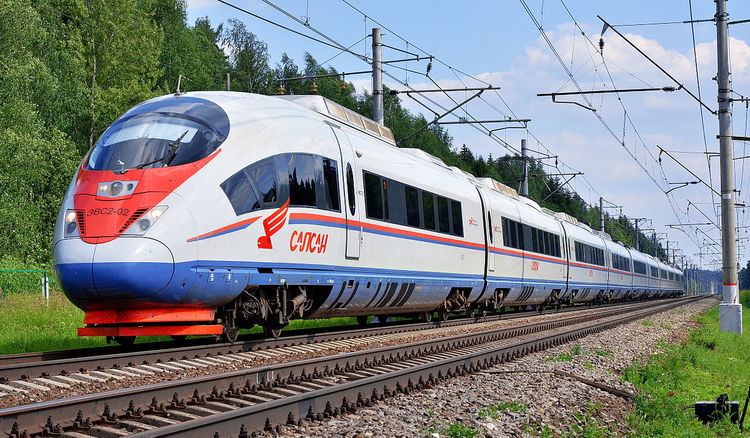In service 2009–present Family name Siemens Velaro Capacity 604 | Manufacturer Siemens Formation 10 cars Operator(s) Russian Railways | |
 | ||
The Sapsan (Russian: Сапсан, 'Peregrine Falcon', known as Velaro RUS EVS) is a Russian gauge high speed electric express train. The design is part of the Siemens Velaro family.
Contents
- Construction history
- Operations
- Moscow Saint Petersburg route
- Moscow Nizhny Novgorod route
- Tickets
- References
The trains started regular service on the Moscow – Saint Petersburg Railway in December 2009 at a maximum speed of 250 km/h (155 mph) (a new build high-speed line would allow for speeds of up to 350 km/h or 217 mph).
Construction history
On 18 May 2006, Siemens and Russian Railways signed a €276 million order for eight high-speed trains with a 30-year service contract worth around €300 million.
The trains were ordered to connect Moscow with Saint Petersburg and later Nizhny Novgorod at a speed of up to 250 km/h (155 mph). They are derived from the German ICE 3 train but with bodies widened by 330 mm (13 in) to 3,265 mm (10 ft 8.5 in) to suit Russia's wide loading gauge. Four of the trains (EVS2) are equipped for both 3 kV DC and 25 kV 50 Hz AC operation. The total length of each ten-car train is 250 m (820 ft), carrying up to 600 passengers.
Development and construction was carried out by Siemens at Erlangen and Krefeld in Germany. In August 2009, it was announced that the fifth Sapsan had been delivered to Russia, of the eight that were planned.
Four single-voltage ("EVS1", 3 kV DC powered, trainsets 5-8) trains entered passenger service at the end of 2009 on the Moscow – St Petersburg route, with the dual-system trains (EVS2, trainsets 1-4) entering service on the Nizhny Novgorod route on 30 July 2010.
Sapsan set records for the fastest train in Russia on 2 May 2009, travelling at 281 km/h (175 mph) and on 7 May 2009, travelling at 290 km/h (180 mph).
On 19 December 2011, a €600 million order for an additional twenty trainsets including eight EVS2 sets was signed in order to facilitate an increased number of services on existing lines and the expansion of new service elsewhere in the system. The second-batch EVS1 sets (trainsets 9-20) will be same details as the first-batch EVS1 sets, but the second-batch EVS2 sets (trainsets 21 onward) will have retractable steps to suit for low platforms, unlike the first-batch EVS2 sets.
Operations
Since entering service in December 2009, it has been Russian Railways' only profitable passenger service, with an occupancy rate of 84.5%. According to the timetable valid from 30 October 2011, the direct train from Moscow to St Petersburg without intermediate stops needs three hours 40 minutes, the train from Moscow to Nizhniy Novgorod three hours 55 minutes.
Introduction of Sapsan initially provoked cancelling of affordable daytime trains between Moscow and St Petersburg. Since the end of 2012, Moscow – St Petersburg daytime trains other than Sapsan were running again.
There were a series of stone throwing attacks against Sapsan trains. Possible reasons including cancelling of commuter trains, disruption of local transportation in rural areas, and accidents because of poor safety for pedestrians have been suggested. New bridge crossings were built, platforms along the railway were reconstructed and additional track was completed in 2015. New Lastochka commuter trains were introduced on the Moscow – Tver and St Petersburg – Bologoye routes. Local trains in the rural areas were saved.
Moscow - Saint Petersburg route
The first and the only (since 2015) route for Sapsan trains.
Moscow (Leningradsky railway terminal) – Tver (770A, 772A, 776A, 756A, 768A, 780A) - Vyshny Volochyok (756A, 760A, 768A, 772A, 780A) - Bologoye (754A, 758A, 770A, 778A) - Uglovka (754A, 776A, 778A) - Okulovka (754A, 758A, 778A) - Chudovo (754A, 770A, 778A) - Saint Petersburg (Moskovsky railway terminal)
There are no Sapsan trains stopping at all stations on the route. The fastest ones do not stop between Moscow and Saint Petersburg at all. Numbers of the trains which stop at intermediate stations are listed above. Such measures were implemented to increase speed.
Moscow – Nizhny Novgorod route
Former route of Sapsan trains. Since 2015, new Talgo Strizh train was introduced. All the Sapsans were directed to Moscow – St Petersburg route. Talgo trains are also high speed but more suitable for this route.
Tickets
On July 1, 2012, the Russian Railways company introduced a new tariff system for Sapsan trains which dynamically prices tickets based on two factors:
The new rates range from 0.8 to 1.2 times the base rate for the day. It is possible to see the final price of a ticket for a specific date during the booking process.
